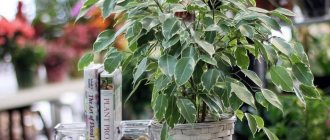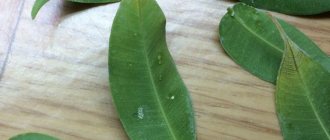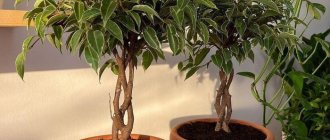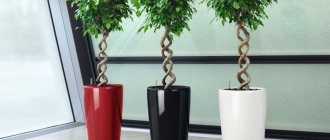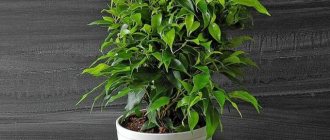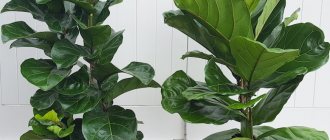Ficus Benjamin has a rather “controversial” character; novice gardeners flatly refuse to acquire this plant. The reason for this attitude towards the tree is its “ability” to shed all its leaves at once if not properly cared for.
Slow plant growth can also be considered a disadvantage of indoor plants. However, if you manage to establish proper care for your ficus, which our article will definitely help you with, then you will get a beautiful, evergreen tree that you can even decorate in bonsai style.
Ficus benjamina indoors - description
Ficus benjamina belongs to the genus Ficus of the Mulberry family. This evergreen plant is an elegant tree or shrub with small leaves and thin slender stems. In the wild it grows in Asia and northern Australia, preferring to settle in damp forests and foothills.
The height of Ficus Benjamin can reach 30 m, but at home it rarely grows more than 2 m. There are also more compact varieties up to 50 cm in height. At the same time, the growth rate of this species is not rapid, but a home tree can easily add about 20 cm in a year New branches appear from any dormant bud on the trunk and branches, creating a lush and beautiful crown.
The trunk of Ficus Benjamin is slender and graceful. The stem and branches of the plant are covered with thin light brown textured bark. Typically the plant forms only one trunk with many thin and flexible branches. This feature gives Ficus benjamina a resemblance to a birch tree, which is why people have given it the affectionate name “Ficus birch”. The branches of the plant actively branch and are densely covered with beautiful leaves.
Benjamin leaves are small, thin, oval-shaped with a pointed end. The color of the leaves can be very diverse. In nature, the color range of leaf blades of this species is represented by dark shades of green, but varieties of Ficus benjamina can boast a wider palette of shades. Various varieties with leaves of light green and light green, decorated with spots and veins of yellow, cream and white colors are very popular among gardeners.
At home, Ficus Benjamina does not form aerial roots, but in the wild, their roots are so numerous and bizarre that they form entire thickets in which an adult can easily walk. Such trees are called banyan trees and they look really impressive.
Does it bloom?
Few gardeners have ever seen Ficus Benjamin bloom. This plant is valued for the beauty of its crown, but in nature or special greenhouses it may well please with its flowering. The flowers of this tree resemble round peas in appearance and are called syconia. They form at the ends of branches and are a great test for a weakened tree, so in greenhouses and winter gardens they prefer to simply remove the inflorescences that appear.
How many years does he live?
The homemade Ficus Benjamina can live more than 15 years, but in nature the age of some of its specimens is many decades. With proper care, this spectacular tree can live for a very long time and even be passed on to future generations.
Pruning and shaping the bush
One of the main stages of care is pruning; the crown of the plant and the configuration of the tree are formed. Pruning is done in the warm months, before fertilizing.
To form a lush and beautiful crown, the topmost layer of the shoot is pinched off. After a week or two, the plant is replanted. It is better to finally form the crown on a young plant with a non-woody stem, up to the age of 3 years. Long and crooked shoots, yellowed, dried and infected twigs and leaves are also removed.
Milk appears at the cut sites; it must be wiped off with a sterile cloth until it stops completely and sprinkled with charcoal.
Flower growers can give the ficus a beautiful and unusual shape, such as a pigtail, trellis, spiral and others.
To weave the stems into a braid, three plants are planted side by side in a pot at the same time, which are gradually intertwined with each other, the side shoots are cut off. To make the trunk look uniform, the bark at the points of contact is cut, and the trees grow together.
It takes some effort to shape a lattice of eight ficus trees. It is necessary to allocate an appropriate place in the house for a large pot. You can braid a cylindrical object (cardboard tube). Rope or wire will also help achieve the result, which can later be easily removed.
If desired, Ficus Benjamin can be shaped into a bonsai-style tree with a height of 30-60 cm. A lover of this type of art will only have to master the basics of plant formation and carry out their plans.
How to care for ficus benjamina at home
Flower growers fell in love with Benjamin for his simple character. If you follow a few rules, this plant will be a worthy decoration for your home’s green corner.
Lighting
Ficus benjamina requires plenty of sunlight when growing, but the plant does not tolerate direct sunlight. It can be placed on the windowsill of an eastern or western window, and larger specimens can be placed near southern windows. On a northern window, due to lack of light, growth slows down and the crown thins out.
Varieties whose leaves are decorated with many light spots require much more light, otherwise they will begin to lose their beautiful color. Such specimens may require additional lighting with fluorescent lamps or special lamps for plants.
Temperature
The Benjamin tree is quite thermophilic, but can easily grow at normal room temperature. The optimal maintenance temperature in the warm season is about +18-+250C. In winter, the temperature in the room should not fall below +160C. The plant does not tolerate drafts, so to prevent the flower from freezing, it is taken to another room during ventilation, since the plant sheds its leaves when exposed to cold air.
It should be borne in mind that variegated varieties of Ficus benjamina need warmer maintenance and are extremely critical of temperature changes.
Humidity
The room where Ficus benjamina grows should have high humidity. It can grow at normal humidity typical of a living room, but you need to regularly spray the crown with warm water from a spray bottle. The leaves of the tree dry out from the hot air when heating devices are operating, so in winter it is removed away from the radiators. You can increase the humidity using a household humidifier; you can also place a flower pot on a tray with expanded clay or wet moss.
Watering
Water the Benjamin tree abundantly, but without allowing the substrate to become waterlogged. Water for irrigation should be soft, at room temperature.
In summer
In the warm season, water every 3-4 days. Watering should be plentiful, as the contents of the pot dry out 3 cm deep. The earthen ball should not be allowed to dry out, as in this case the growth of Ficus Benjamin will stop and it will begin to lose leaves.
in winter
In winter, watering is reduced to moderate. The soil in the pot is moistened approximately once a week, as the top layer dries.
Fertilizer and feeding
From March to October, Ficus Benjamina needs special feeding. Fertilizers are applied 2 times a month, and you can use complex mineral fertilizer or alternate it with organic matter.
When choosing a preparation, it is important to pay attention to the ratio of components, since a high nitrogen content can lead variegated varieties to a completely ordinary monochromatic appearance and loss of characteristic spots. In flower shops you can find special fertilizers for ficus plants. Agricola for Ficus benjamina can be an excellent feeding option. It is used according to the instructions, strictly observing the dosage.
Fertilizers can be applied to the soil or on the leaves. For this you can also use special preparations and mineral fertilizers, but in weaker concentrations.
Special feedings will help not only stimulate the growth of the flower, but also help it recover after a change of place of residence or illness. In order for the plant to better withstand stress, it is sprayed and watered with succinic acid or epin. Succinic acid for Ficus Benjamin serves as a good antidepressant and helps to recover, even if it has lost most of its leaves. It is diluted with water and applied along with watering or sprayed on the crown in a more reduced concentration. After some time of this “therapy”, the ficus comes to life again and begins to actively grow green mass. How to breed Epin for Ficus benjamina can be found in the instructions. This drug has a complex effect and is used for many indoor and garden crops. Just 3-4 drops per 1 liter of warm water are enough to water the bush, after which it regains its vibrant appearance and gradually regains its attractiveness.
Pruning and crown formation
Ficus benjamina lends itself well to pruning and crown shaping. You can create a beautiful shape simply by periodically removing overgrown branches. Usually the plant is given the shape of a lush bush, every spring shortening the main branches to 15 cm and the side branches to 10 cm. The bush will quickly restore its shape and begin to actively increase the lost volume. All branches growing inside the crown are pruned so as not to disrupt air circulation.
To give the Ficus benjamina the shape of a beautiful tree, remove all the side branches on the main trunk. For uniform development of the crown, you need to periodically turn the flower pot in relation to the light source, then the ficus will develop evenly on all sides.
If you need to stimulate the growth of lateral branches on the trunk, you can resort to a little trick and use special means. Cytokinin paste for Ficus Benjamin serves as a stimulator for the awakening of dormant buds. She does an excellent job even if the bush has been significantly damaged by a draft or improper care. To do this, just make small cuts on the trunk of the plant and apply a small drop of paste onto them with the tip of a toothpick. After some time, new branches will begin to appear on the trunk. Just keep in mind that cytokinin paste stimulates the growth of new shoots, but in order for them to grow and develop well, the plant must be well fed and provided with everything necessary for vigorous growth, otherwise new branches will grow disproportionately and may disrupt the decorative appearance of the Benjamin tree. Also, when using special means in variegated varieties, new branches often grow with monochromatic leaves.
How to braid a trunk
The thin and graceful stems of Ficus benjamina are often used to create real living sculptures. The beautiful columns of intertwined trunks of this plant look very attractive, while the ficus does not suffer at all and continues to grow. Weaving Ficus Benjamin is not a complicated process, but it requires a lot of patience, since the formation of an openwork trunk does not occur in a few days, it will take months and even years.
To do this, you need to take several ficus cuttings and plant them in one pot. The planting density depends on the desired result: if you need to tightly intertwine the stems to get a tight twisting trunk, then the seedlings are planted close to each other, at a distance of only 5-10 cm, and when creating an air column, the distance can be increased.
As the seedlings grow, they are braided, secured with plaits and tied with electrical tape. Tightly planted plants are carefully twisted in a spiral and secured. Over time, they will grow together into one dense and beautiful trunk.
Openwork columns are created by crossing and securing young ficus trees. In the middle of the plantings, it is advisable to place a pipe made of plastic or cardboard, around which patterns will weave. In this case, you need to constantly remove all excess lateral growth, leaving leaves and twigs on the crown. The stems are crossed at the desired distance from each other and secured with strands. After they grow together, the tourniquets are removed. For such a composition, it is advisable to plant at least 5 seedlings. More complex and beautiful ornaments are obtained by using 8-10 young plants.
Description of the plant
Externally, ficus benjamina resembles a small tree. The short trunk is covered with gray-beige bark.
Benjamin's crown is lush and branched.
The tropical past of the indoor plant is reminiscent of aerial roots or their rudiments (in their natural habitat they absorb water from the air).
The color of the leaves ranges from solid green or light to variegated with a wide variety of “graphics” of the pattern.
REFERENCE: Flower shops often offer customers three plants at once, planted in one pot, with woven trunks.
Original option - this cannot be done with any other representatives of indoor flora. However, you can also purchase a single Ficus Benjamina plant.
If you need to landscape a winter garden or greenhouse, it is difficult to choose something better than ficus.
The rich, glossy foliage combines well with other indoor plants and does not require any special, labor-intensive care.
Motherland
The homeland of indoor Benjamin is the tropical forests of Asia. This member of the mulberry family is found today in China, India, Australia, Hawaii and the Philippines.
In its natural habitat it stretches up to 25 meters in height. While his indoor relative reaches a little over a meter, and it takes him about ten years to do this.
REFERENCE: Residents of Thailand expressed their respect for the plant by calling Ficus Benjamin the symbol tree of the country's capital, Bangkok.
Crown
A houseplant quickly becomes lush and branches well, so the formation of a plant crown is one of the main directions in plant care. The shape of the “haircut” can be chosen from several options:
- bush-like;
- in the form of a ball;
- in the form of any sculpture;
- according to the bonsai principle.
By the way, the “bonsai” haircut works well due to the fact that the ficus shoots do not lose their elasticity for a very long time and allow you to perform all the necessary manipulations with them.
ATTENTION: It is advisable to trim the crown during accelerated growth - in spring or at the very beginning of summer.
It should also be borne in mind that the younger the plant, the easier it is to trim.
You also need to know a number of rules: use only sterile instruments, protect the bark from damage, and do not pick off the leaves by hand.
It is worth adhering to the principle of measuring seven times before using scissors or pruners: so as not to spoil the appearance of the plant.
Try to mentally keep in mind the result you are striving for, and cut off only those branches that do not fit into the ideal image created by your imagination.
You can weave a braid or spiral from semi-lignified stems, as specialized stores offer, on your own, but not before the lower part of the plants, with which you begin weaving, reaches a length of thirteen centimeters.
As it grows further, turn after turn is added, and the braid itself (so that it does not unravel) is held in place with electrical tape or woolen thread. By the way, the plant only benefits from such a “braid” - the stems become stronger.
Root system
Benjamin's roots are generally very strong. It is no coincidence that in their homeland the plant takes measures to protect sidewalks and underground communications from the destructive effects of its roots.
For a houseplant, it is important to choose the right pot. It should not be too large or wide - in this way the ficus will grow slowly, mastering the underground space centimeter by centimeter. But there is no need for cramped space - the root system should be comfortable.
TIP: Repotting may only be necessary when the roots fill the entire pot. This is a signal that a larger container is needed.
Aerial roots, characteristic of ficuses growing in the natural environment, are observed quite rarely in indoor plants: there is simply no special need for them; the efforts of the traditional root system are enough to extract water and nutrients from the soil.
Bloom
The plant blooms only in natural conditions and in greenhouses, the climate and conditions of which are close to natural. However, there are no rules without exceptions: according to flower growers, their home ficus trees sometimes bloomed.
The inflorescence, called a syconium, looks more like a red berry with a small hole, and if you don't know what it is, you might start to worry if your plant has some kind of strange disease.
Reproduction
It is quite easy to propagate Ficus benjamina at home. To do this, just cut off a small branch and root it in water, and then plant it in the substrate. You can also use the layering method, and enthusiasts can try to grow beautiful and rare varieties from seeds.
Cuttings
Cuttings are the easiest and fastest way to get a new bush. To do this, separate a twig 8-10 cm long. It is advisable to choose not young green twigs, but semi-lignified ones. Drops of milky juice are removed from the cutting site, the cuttings are placed in a glass of water and covered with a transparent cap. As a rule, after 1-2 weeks the first roots will begin to appear. When they grow to 5 cm, the seedlings are planted in a pot with substrate.
By layering
A small circular cut is made on a bare branch, wrapped in damp moss, and covered with a transparent film on top. The film is secured at the top and bottom with thread or soft wire. From time to time you need to moisten the moss; to do this, open the film from above and drop a couple of drops of water under it. As roots begin to appear on the stem, the branch is cut off and rooted in a pot with substrate.
Seeds
New varieties of Ficus benjamina can be grown from seeds. To do this, the material is pre-soaked for a day in warm water, then sown in a peat-sand mixture. The seeds are planted to a depth of 0.5 cm, sprinkled with earth, covered with film and placed in a warm, bright place. For germination, seeds are kept at a temperature of +25-+270C. The film is removed daily for 10-15 minutes, the greenhouse is ventilated and, if necessary, the surface of the substrate is moistened with a spray bottle. When the first shoots appear on the soil surface, the film is removed. The seeds may take about 2-3 months to germinate, so you need to be patient. After the seedlings hatch and grow a few leaves of their own, they are transplanted into small pots with suitable soil.
Ficus benjamina transplant
In order for Ficus Benjamin to grow well and develop normally, we must not forget about regular replanting. To prevent the plant from experiencing severe stress, it is transferred from the old pot to a new one without shaking the earthen ball. During planting, a drainage layer of pebbles, expanded clay, and small stones must be placed at the bottom of the pot. During transplantation, the plant is placed in a pot and the remaining space is filled with soil mixture, a little soil is poured on top, but the root collar is left at the same level.
When to replant
Benjamin is replanted in the spring. For the first 4 years, plants are replanted annually, and after that only once every 2-3 years.
Priming
Full growth and development of a plant is impossible without a high-quality substrate. You can purchase a special soil mixture for ficuses in the store, but if desired, suitable soil can be prepared from equal parts of sand, peat, turf and leaf soil. A little charcoal is added to the finished substrate.
Pot
A pot made of any material will do. It can be ceramic or plastic, but there must be a sufficient number of drainage holes at the bottom of the container. A pot that is too high may be unstable and will tip over, so the new planting container should be 2-3 cm wider than the previous one.
How to water
— Watering should be plentiful and thoroughly saturate the soil with moisture. But overmoistening is not allowed. The frequency of watering depends on the season. In autumn, watering is reduced. In winter, when the plant is in the dormant phase, watering should be reduced further. Before watering, we always check the moisture level of the earthen ball. Ficuses do not like too wet soils, but also do not tolerate drying out of the earthen clod. But in the peculiarities of winter heating of apartments, we water regularly.
— Feeding is carried out twice a month using liquid mineral fertilizers. We fertilize from spring to autumn, during active growth. On sale you can find specialized complex fertilizers for feeding ficus plants. Or you can choose fertilizers for decorative foliage or a universal fertilizer for indoor plants. When watering, dilute the fertilizer slightly less than the specified rate. This will prevent you from burning the ficus roots.
To give ficus trees their shape and form a neat crown, trim the apical shoots. Side shoots will appear and the crown will be thicker.
Diseases and pests of Ficus Benjamin with photos and their treatment
In general, Ficus benjamina is quite hardy and, with proper care, rarely suffers from diseases and pests.
If not properly cared for, the bush can be attacked by scale insects, spider mites, mealybugs or aphids.
Aphids on Ficus benjamina attack young leaves and growing points. This pest forms entire colonies and sucks juices from young branches. You can get rid of aphids by washing with soapy water and treating with special insecticides.
Spider mites on Ficus benjamina appear in dry indoor air. The infected plant does not grow, begins to wither, turns yellow and drops its leaves. The first thing to do when you find cobwebs on your Ficus benjamina is to increase the humidity in the room. To do this, install a humidifier, vessels with water nearby, or sprinkle with water mist. Spraying with a soap solution, Aktara or Aktellik will help get rid of pest colonies. Afterwards, the bush is covered with a transparent cap or bag and ventilated daily.
Sticky leaves indicate a scale infestation. A related problem may be sooty fungus, which is very fond of the sweet secretions of this pest. The infected plant is washed with soapy water and treated with Actellik.
White lumps at the base of the leaves may indicate a mealybug problem. This pest has a small body, as if covered with cotton wool. How to deal with mealybug on Ficus benjamina:
- Remove white spots on the leaves of Ficus benjamina using a soft sponge soaked in soapy water.
- Treat all parts of the plant with soapy water.
- Treat with insecticide.
After this, you can trim the bush, and when it is completely restored, then spray it with epin or succinic acid.
Among the diseases, anthracnose, powdery mildew and root rot can be dangerous.
Anthracnose in Ficus benjamina can be recognized by the red spots on the edges of the leaf blades. Afterwards, the leaves become covered with holes and die. The plant is treated with special fungicides.
Powdery mildew on Ficus benjamina appears as a white coating on the leaves and branches. It is difficult to fight the disease; it is easier to cut off all infected parts and treat the plant with a fungicide.
When root rot occurs, the entire plant withers, turns yellow and loses its foliage. In this case, it is removed from the pot, cleared of soil and all affected parts are removed. After this, the plant is planted in a fresh substrate and treated with fungicides.
The following difficulties may also arise:
- The leaves of Ficus Benjamin turn black due to poor watering, low humidity in the room or an incorrectly selected substrate.
- The leaves of Ficus benjamina are drying due to dry air.
- Spots on the leaves of Ficus benjamina - yellow and brown spots on the leaves indicate too much light and exposure to direct sunlight.
- Leaves curl and wither - a draft or low temperature in the room.
- Thin and weak shoots - lack of light and nutrition.
With regular inspection of the plant and compliance with the rules of care, the house ficus will grow for a long time and delight its owner. A sudden change in living conditions can cause stress in the plant, so at first it can be sprayed with a solution of succinic acid or epin.
FAQ
Is Ficus Benjamin poisonous?
No matter how beautiful this plant looks, its juice is slightly toxic and can cause allergies. Avoid contact with him. Those who have children should especially pay attention to this.
Ficus Benjamina also poses a danger to pets: cats love to chew shoots, and dogs eat falling leaves. It is necessary to protect your pets from this.
Anyone who is allergic to milky sap should avoid contact with the plant's sap, as it can cause severe allergic reactions, including anaphylactic shock.
Consumption of plant parts may cause nausea, vomiting and diarrhea.
Why does Ficus benjamina shed its leaves?
First of all, it should be noted that the plant regularly loses leaves. This is normal as long as the leaf fall does not get out of control. If a lot of leaves are constantly falling, you need to find the reason for this.
- Changing the location of a plant is a common cause of leaf shedding. The ficus must get used to the new place. But it happens quite quickly;
- Incorrect location: too much sun or too little light (noticeable when one-sided dropping of foliage);
- Too low temperatures, less often - too high temperatures or temperature fluctuations;
- Humidity too low;
- The substrate is too wet: the roots begin to rot;
- Pest infestation;
- Diseases, for example, fungal infection;
- Draft;
- Too few nutrients.
All causes must be eliminated. In the case of root rot, it is best to remove the plant from the pot, remove loose soil, and trim the root. Remove any parts that look rotten. Then return the plant back to the pot filled with fresh soil and water a little. This measure is not a guarantee that Benjamin's ficus will survive, but it is worth a try.
Share this article
Ficus benjamina - popular varieties with photos and names
Ficus benjamina is very popular among flower growers, and therefore is of great interest to breeders. As a result of selection, on store shelves you can find a huge number of cultivated varieties with very different bush shapes and leaf colors.
Natasha
Dwarf Ficus Benjamin with a lush but compact crown and small variegated leaves. The leaves of the variety are dark green with cream spots and a border.
Kinky
The foliage of this variety is dark green with light edges. The leaves are small, up to 5 cm in length. The crown is lush, but requires regular pruning.
Daniel
The leaf blades of this species are shiny and dark green. The edge of the sheet is smooth.
Dunetti
Ficus with beautiful small heart-shaped leaves. The stems are drooping, so several bushes are often planted in one pot so that they can keep their shape.
Starlight
A variety with dark leaf blades and light cream spots along the edges.
Golden King
The leaf blades are painted a light shade of green with a white edge.
Anastasia
A variety with dark green leaves, decorated with a light green border and vein.
Esther
The leaves are light green, smooth, shiny.
Exotic
The leaves are dark with a wavy edge.
Baroque or Curly
Ficus leaves are light green, twisted into beautiful rings.
Twilight (Twilight)
A variegated variety with a dark green leaf plate, decorated with a white border and streaks of light green and white. In bright light, the color of the leaf can change to almost white.
Nina
Small-leaved ficus with a lush crown. The leaves are narrow, gray-green, decorated with a thin yellowish border.
Golden Monique
A variety with thin drooping branches and elongated leaves with a wavy edge. The foliage color is golden-green with a prominent central vein.
Reginald
The leaf blades are light, with dark spots in the center.
Safari
A plant with small boat-shaped leaves. The color is marbled, combining dark green and frequent strokes and streaks of cream color. In bright light, the bush acquires a more variegated color, and some plates become almost completely white.
Curly
A variety with small leaf blades slightly wavy along the edge. The main color is dark green with small specks or large spots of white. Some of the leaves of this Ficus benjamina are white and completely devoid of chlorophyll.
Flower design
From a design point of view, ficus benjamina (all its varieties and types) can be grouped into a single composition. Or grow as separate single plants. This ficus is ideal for single planting. Especially if it is already a tall tree. There are several ficus trees on sale whose trunks are intertwined and specially shaped into a braid or spiral. Select different ficus plants, the main thing is to provide them with good growing conditions. Variegated varieties need more lighting.
You can read more about caring for ficuses HERE.
When creating compositions, you can use different varieties and types of ficus. We plant a tall ficus in the center of the composition. If its trunks are formed into a spiral or braided, then at the foot you can plant an ampel-shaped ficus, which will gracefully hang from the flowerpot and entwine the trunk. Or choose ficus kinki and also plant it at the foot of the main ficus. This dwarf form of ficus will complement the main plant. You can also combine several varieties of ficus in one composition. Take a variety with juicy dark green foliage and plant it next to lighter (light green) foliage and add variegated foliage. Good luck to you.
What Ficus Benjamin brings to the house: signs and superstitions
There are many superstitions associated with Ficus Benjamin. If in the East this plant is considered to be a symbol of wealth and prosperity, then in Russia and the CIS countries the ficus is called “muzhegon” and is credited with magical properties that have a negative impact on family members.
In China, Ficus Benjamin is given as a wedding gift and passed on from one generation to another, and in some Eastern countries this beautiful tree is considered sacred. At home, ficus is able to absorb negative energy, attract wealth into the house and help in amorous matters. If you give Ficus Benjamin to a childless couple, they will soon have a child.
But in order for this tree to have a positive effect on the “weather in the house”, it must be placed correctly:
- Kitchen - wealth and relief from financial problems.
- Office - good luck at work and increased productivity.
- Bedroom – improved sleep, relief from anxiety and quick pregnancy.
You should not place a pot of Ficus benjamina on the north or west side of the house. Then the plant will not have enough sun, and it will not be able to influence the microclimate in the family.
In any case, everyone decides for himself whether to believe or not to believe in various superstitions. But in any case, if this beautiful and lush tree appears in the house, the room immediately transforms and becomes more comfortable.
Benefits and harms
In addition to aesthetic pleasure, an indoor dwarf plant releases oxygen and normalizes the microclimate in the room. The green color of the leaves pleases the human eye, lifts the mood, and helps treat depression. The flower has some drawback - at night, the ficus releases a small amount of milky juice into the air.
It causes skin irritation and various allergic reactions.
ATTENTION! Adults and children suffering from asthma and other respiratory ailments are not recommended to keep all types of ficus in the house.
Photos in the interior
Ficus benjamina is a luxurious spreading tree that attracts attention with the elegance of its branches and the density of its crown. With proper care, the ficus birch tree will become a real decoration for your home collection, capable of refreshing the interior of a city apartment even on its own.
How to propagate
— Reproduction of Ficus Benjamin is carried out through apical cuttings. Propagation by cuttings is the best way. They need to be cut back in the spring. And place for rooting in a protected place at a temperature of 20-22 degrees. Difficulties with rooting may arise with variegated forms, as they take longer to take root than green-leaved ficuses. Ampelous ficuses can be divided during transplantation, but I do not recommend it, since when dividing the bush, we disturb the roots and this can lead to disastrous results.
